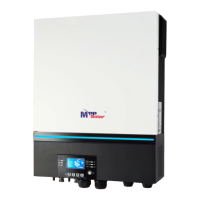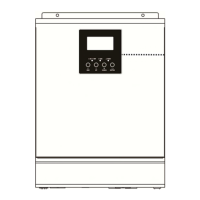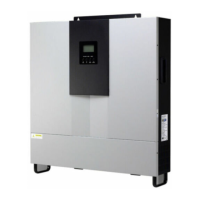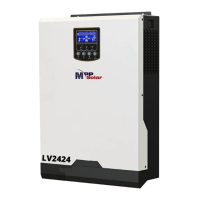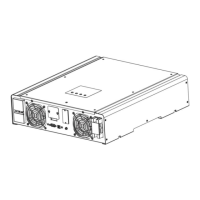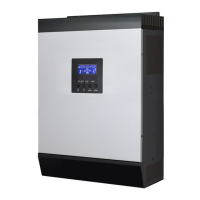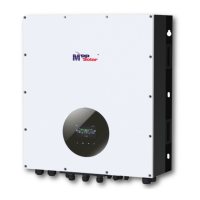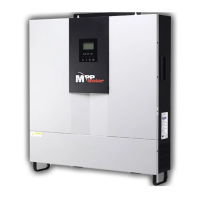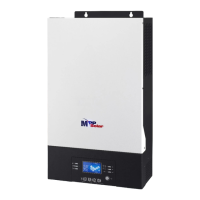
Do you have a question about the MPP Solar PIP5048MKX and is the answer not in the manual?
| Model | PIP5048MKX |
|---|---|
| Rated Power | 5000W |
| Battery Voltage | 48VDC |
| Max. AC Charge Current | 60A |
| Efficiency | 93% |
| Output Voltage | 230VAC |
| Output Frequency | 50Hz/60Hz |
| Max PV Array Open Circuit Voltage | 145VDC |
| Communication | RS232/USB |
| Input Voltage Range | 90-280VAC |
| Max PV Input Voltage | 145VDC |
| Battery Type | Lead-acid/Lithium |
| Cooling | Fan cooling |
| Protection | Overload, Short circuit, Over temperature |
Explains the manual's scope and content.
Outlines safety and installation guidelines, tools, and wiring.
Lists key features of the inverter/charger.
Illustrates a typical system setup with inverter, PV, and appliances.
Describes the physical components and ports of the inverter.
Details items received and checks for damage.
Instructions for preparing the unit before wiring.
Guidelines for selecting an installation location and orientation.
Instructions for connecting the battery, including cable and terminal specs.
Guide for connecting AC input/output, including breaker specs and wiring.
Instructions for connecting PV modules, including selection criteria and wiring.
Instructions for re-attaching the bottom cover after wiring.
Steps for installing the optional remote LCD panel.
How to connect to a PC via serial cable for monitoring.
Details on using the Wi-Fi transmitter and the WatchPower app.
Explains the function of the dry contact terminal.
Information on connecting to lithium batteries via BMS.
How to turn the unit on and off.
Describes the front panel controls and display indicators.
Explains the function of each button on the control panel.
Details the meaning of icons shown on the LCD display.
Explains how battery status is displayed on the LCD.
How load levels are indicated on the LCD.
Icons representing different operational modes.
How to access and configure settings via the LCD panel.
How to use USB for firmware upgrade, data export, etc.
How to cycle through display information on the LCD.
Explains different operating modes like Standby, Fault, Bypass/ECO.
Lists fault codes, events, and corresponding icons.
Details warning codes, events, audible alarms, and icon flashing.
Functionality and benefits of battery equalization.
Steps to enable and apply equalization.
Conditions under which equalization is performed.
Technical specifications for the inverter in Line Mode.
Technical specifications for the inverter in Battery Mode.
Specifications related to charging modes and curves.
Specifications for solar input and MPPT.
Specifications for ECO/Bypass modes.
General specifications like operating temperature, dimensions, etc.
Common problems, explanations, and solutions for troubleshooting.
Overview of parallel operation applications and capabilities.
Lists items included in the parallel kit.
Steps for installing the parallel board.
Installation guidelines for multiple units in parallel.
Details on battery and AC cable sizes for parallel operation.
Wiring diagrams for single-phase parallel connection.
Diagrams for three-phase parallel configurations.
Refers to single unit manual for PV connection details.
Details on setting AC output mode and fault code display.
Steps for commissioning parallel single-phase systems.
Steps for commissioning three-phase systems.
Troubleshooting common issues in parallel/3-phase systems.
Table showing backup time estimates based on load and battery capacity.
Introduction to BMS communication and required cables.
Configuration of DIP switches for PYLONTECH batteries.
Steps to install and operate with PYLONTECH lithium batteries.
Steps for WECO lithium battery communication.
Steps for SOLTARO lithium battery communication.
How to view battery pack and group numbers on the LCD.
Explanation of codes displayed for battery communication status.
Overview of Wi-Fi module and WatchPower APP functions.
Instructions for downloading and installing the WatchPower app.
Steps for registering and setting up the Wi-Fi connection.
Configuring Wi-Fi network settings on the phone.
Completing Wi-Fi configuration and troubleshooting.
Using the diagnose function for troubleshooting Wi-Fi issues.
Logging into the app and overview of main functions.
Adding and managing devices in the app.
Viewing device information and real-time status.
Understanding different device operating modes displayed.
Reviewing alarms and modifying device names.
Accessing detailed device information.
How to activate features and set parameters for inverters.



